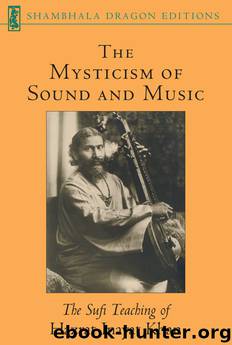The Mysticism of Sound and Music by Hazrat Inayat Khan

Author:Hazrat Inayat Khan
Language: eng
Format: epub
Publisher: Shambhala Publications
CHAPTER VIII
Abstract Sound
ABSTRACT SOUND is called sawt-e-sarmad by the Sufis; all space is filled with it. The vibrations of this sound are too fine to be either audible or visible to the material ears or eyes, since it is even difficult for the eyes to see the form and colour of the ethereal vibrations on the external plane.
It was the sawt-e-sarmad, the sound of the abstract plane, which Muhammad heard in the cave of Ghar-e-Hira when he became lost in his divine ideal. The Qur’an refers to this sound in the words: ‘Be! and all became’.
Moses heard this sound on Mount Sinai when in communion with God, and the same word was audible to Christ when absorbed in his heavenly Father in the wilderness. Shiva heard the same anahad nada during his samadhi in the cave of the Himalayas. The flute of Krishna is symbolic of the same sound. This sound is the source of all revelation to the Masters to whom it is revealed from within. It is because of this that they know and teach one and the same truth.
The Sufi knows of the past, present and future, and about all things in life, by being able to know the direction of sound. Every aspect of one’s being in which sound manifests has a peculiar effect upon life, for the activity of vibrations has a special effect in every direction. The knower of the mystery of sound knows the mystery of the whole universe. Whoever has followed the strains of this sound has forgotten all earthly distinctions and differences, and has reached that goal of truth in which all the blessed ones of God unite.
Space is within the body as well as around it; in other words, the body is in the space and the space is in the body. This being the case, the sound of the abstract is always going on within, around and about man. Man does not hear it as a rule, because his consciousness is entirely centred in his material existence. Man becomes so absorbed in his experiences in the external world through the medium of the physical body that space, with all its wonders of light and sound, appears to him blank.
This can be easily understood by studying the nature of colour. There are many colours that are quite distinct by themselves; yet, when mixed with others of still brighter hue, they become altogether eclipsed. Even bright colours, when embroidered with gold, silver, diamonds or pearls, serve merely as a background to the dazzling embroidery. So it is with the abstract sound compared with the sounds of the external world. The limited volume of earthly sounds is so concrete that it dims the effect of the sound of the abstract to the sense of hearing, although in comparison to it the sounds of the earth are like that of a whistle to a drum. When the abstract sound is audible, all other sounds become indistinct to the mystic.
The sound of the abstract is called anahad in the Veda, meaning unlimited sound.
Download
This site does not store any files on its server. We only index and link to content provided by other sites. Please contact the content providers to delete copyright contents if any and email us, we'll remove relevant links or contents immediately.
The Goal (Off-Campus #4) by Elle Kennedy(13207)
Kathy Andrews Collection by Kathy Andrews(11331)
Diary of a Player by Brad Paisley(7270)
What Does This Button Do? by Bruce Dickinson(5936)
Assassin’s Fate by Robin Hobb(5858)
Big Little Lies by Liane Moriarty(5519)
Altered Sensations by David Pantalony(4872)
Pale Blue Dot by Carl Sagan(4627)
Sticky Fingers by Joe Hagan(3916)
The Death of the Heart by Elizabeth Bowen(3342)
The Heroin Diaries by Nikki Sixx(3325)
Beneath These Shadows by Meghan March(3153)
Confessions of a Video Vixen by Karrine Steffans(3104)
The Help by Kathryn Stockett(3022)
How Music Works by David Byrne(2968)
Jam by Jam (epub)(2880)
Harry Potter 4 - Harry Potter and The Goblet of Fire by J.K.Rowling(2814)
Strange Fascination: David Bowie: The Definitive Story by David Buckley(2702)
Petty: The Biography by Warren Zanes(2575)
